Improving Accounting Practices: A Study of Inventory Management
VerifiedAdded on 2023/04/22
|9
|1664
|242
Report
AI Summary
This report provides a comprehensive analysis of accounting practices, with a specific focus on improving inventory management within a business organization. It highlights the critical role of efficient inventory management in achieving revenue generation, reducing costs, and ensuring continuous supply to customers. The report identifies deficiencies in the firm's current inventory management methods, such as the failure to utilize the FIFO method, leading to material wastage, revenue loss, and impaired customer relations. Recommendations include integrating customer feedback, training inventory management employees, and aligning inventory practices with overall organizational change to enhance business productivity and sustainability. The study concludes that addressing these issues is essential for the firm to embrace change effectively and improve its financial performance.

Running head: IMPROVING ACCOUNTING PRACTICES
Improving Accounting Practices
Name of the Student
Name of the University
Author note
Improving Accounting Practices
Name of the Student
Name of the University
Author note
Paraphrase This Document
Need a fresh take? Get an instant paraphrase of this document with our AI Paraphraser

1
IMPROVING ACCOUNTING PRACTICES
Executive summary:
The discussion below clearly shows that inventory management and accounting are two crucial
areas in which business organisations have to achieve levels of efficiency. The analysis of the
role of inventory management in successful business operations shows that it is important in
achieving revenue generation and future business generation. Finally it can be concluded that the
firm in the case study should integrate customers and train inventory management employees to
improve its inventory management.
IMPROVING ACCOUNTING PRACTICES
Executive summary:
The discussion below clearly shows that inventory management and accounting are two crucial
areas in which business organisations have to achieve levels of efficiency. The analysis of the
role of inventory management in successful business operations shows that it is important in
achieving revenue generation and future business generation. Finally it can be concluded that the
firm in the case study should integrate customers and train inventory management employees to
improve its inventory management.

2
IMPROVING ACCOUNTING PRACTICES
Table of Contents
Executive summary:........................................................................................................................1
Introduction:....................................................................................................................................3
Main body:.......................................................................................................................................3
The chosen area of account practices and its appropriateness to study:..........................................3
Findings from the analysis:..........................................................................................................4
Present inventory management methods:........................................................................................4
Findings from the analysis:..........................................................................................................5
Conclusion:......................................................................................................................................6
References:......................................................................................................................................7
IMPROVING ACCOUNTING PRACTICES
Table of Contents
Executive summary:........................................................................................................................1
Introduction:....................................................................................................................................3
Main body:.......................................................................................................................................3
The chosen area of account practices and its appropriateness to study:..........................................3
Findings from the analysis:..........................................................................................................4
Present inventory management methods:........................................................................................4
Findings from the analysis:..........................................................................................................5
Conclusion:......................................................................................................................................6
References:......................................................................................................................................7
⊘ This is a preview!⊘
Do you want full access?
Subscribe today to unlock all pages.

Trusted by 1+ million students worldwide
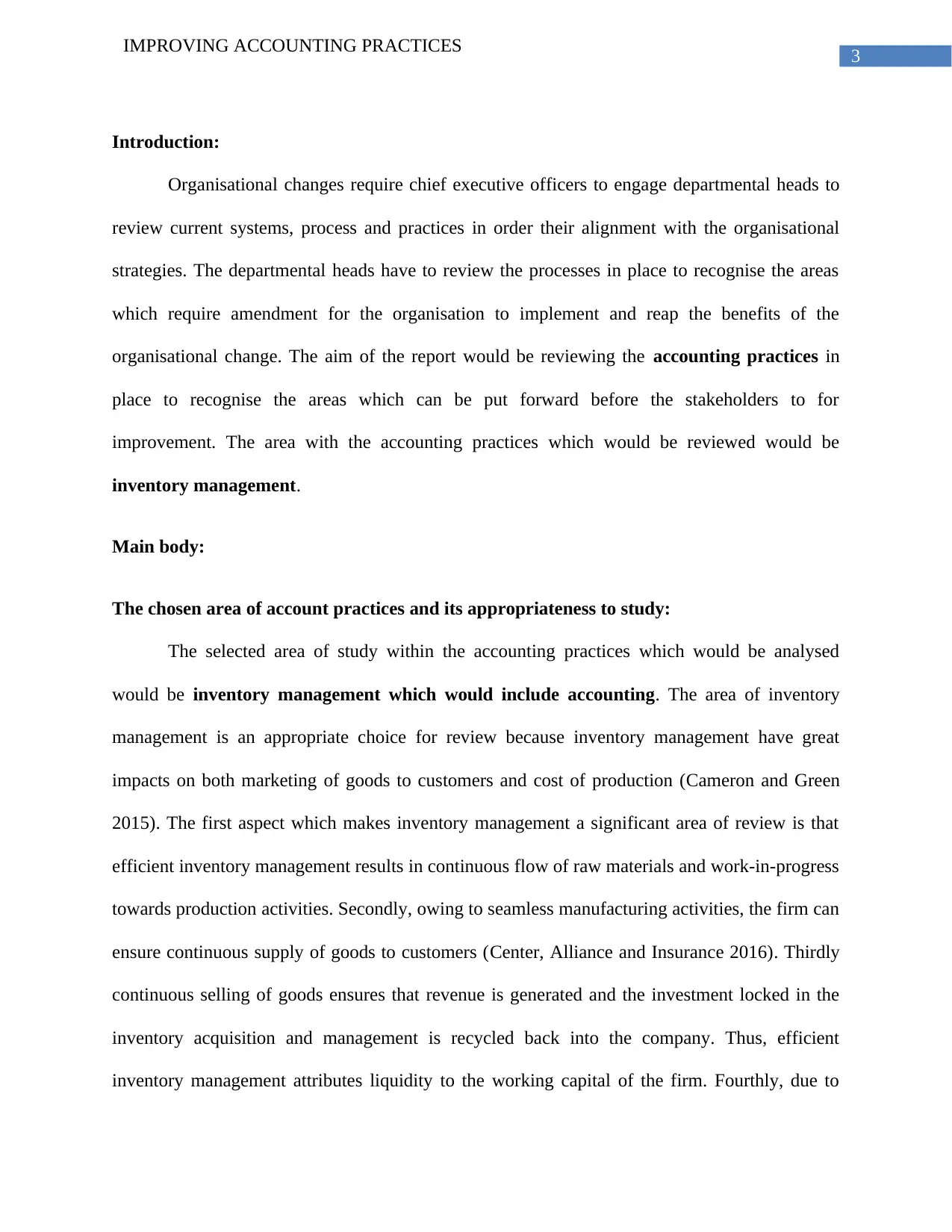
3
IMPROVING ACCOUNTING PRACTICES
Introduction:
Organisational changes require chief executive officers to engage departmental heads to
review current systems, process and practices in order their alignment with the organisational
strategies. The departmental heads have to review the processes in place to recognise the areas
which require amendment for the organisation to implement and reap the benefits of the
organisational change. The aim of the report would be reviewing the accounting practices in
place to recognise the areas which can be put forward before the stakeholders to for
improvement. The area with the accounting practices which would be reviewed would be
inventory management.
Main body:
The chosen area of account practices and its appropriateness to study:
The selected area of study within the accounting practices which would be analysed
would be inventory management which would include accounting. The area of inventory
management is an appropriate choice for review because inventory management have great
impacts on both marketing of goods to customers and cost of production (Cameron and Green
2015). The first aspect which makes inventory management a significant area of review is that
efficient inventory management results in continuous flow of raw materials and work-in-progress
towards production activities. Secondly, owing to seamless manufacturing activities, the firm can
ensure continuous supply of goods to customers (Center, Alliance and Insurance 2016). Thirdly
continuous selling of goods ensures that revenue is generated and the investment locked in the
inventory acquisition and management is recycled back into the company. Thus, efficient
inventory management attributes liquidity to the working capital of the firm. Fourthly, due to
IMPROVING ACCOUNTING PRACTICES
Introduction:
Organisational changes require chief executive officers to engage departmental heads to
review current systems, process and practices in order their alignment with the organisational
strategies. The departmental heads have to review the processes in place to recognise the areas
which require amendment for the organisation to implement and reap the benefits of the
organisational change. The aim of the report would be reviewing the accounting practices in
place to recognise the areas which can be put forward before the stakeholders to for
improvement. The area with the accounting practices which would be reviewed would be
inventory management.
Main body:
The chosen area of account practices and its appropriateness to study:
The selected area of study within the accounting practices which would be analysed
would be inventory management which would include accounting. The area of inventory
management is an appropriate choice for review because inventory management have great
impacts on both marketing of goods to customers and cost of production (Cameron and Green
2015). The first aspect which makes inventory management a significant area of review is that
efficient inventory management results in continuous flow of raw materials and work-in-progress
towards production activities. Secondly, owing to seamless manufacturing activities, the firm can
ensure continuous supply of goods to customers (Center, Alliance and Insurance 2016). Thirdly
continuous selling of goods ensures that revenue is generated and the investment locked in the
inventory acquisition and management is recycled back into the company. Thus, efficient
inventory management attributes liquidity to the working capital of the firm. Fourthly, due to
Paraphrase This Document
Need a fresh take? Get an instant paraphrase of this document with our AI Paraphraser
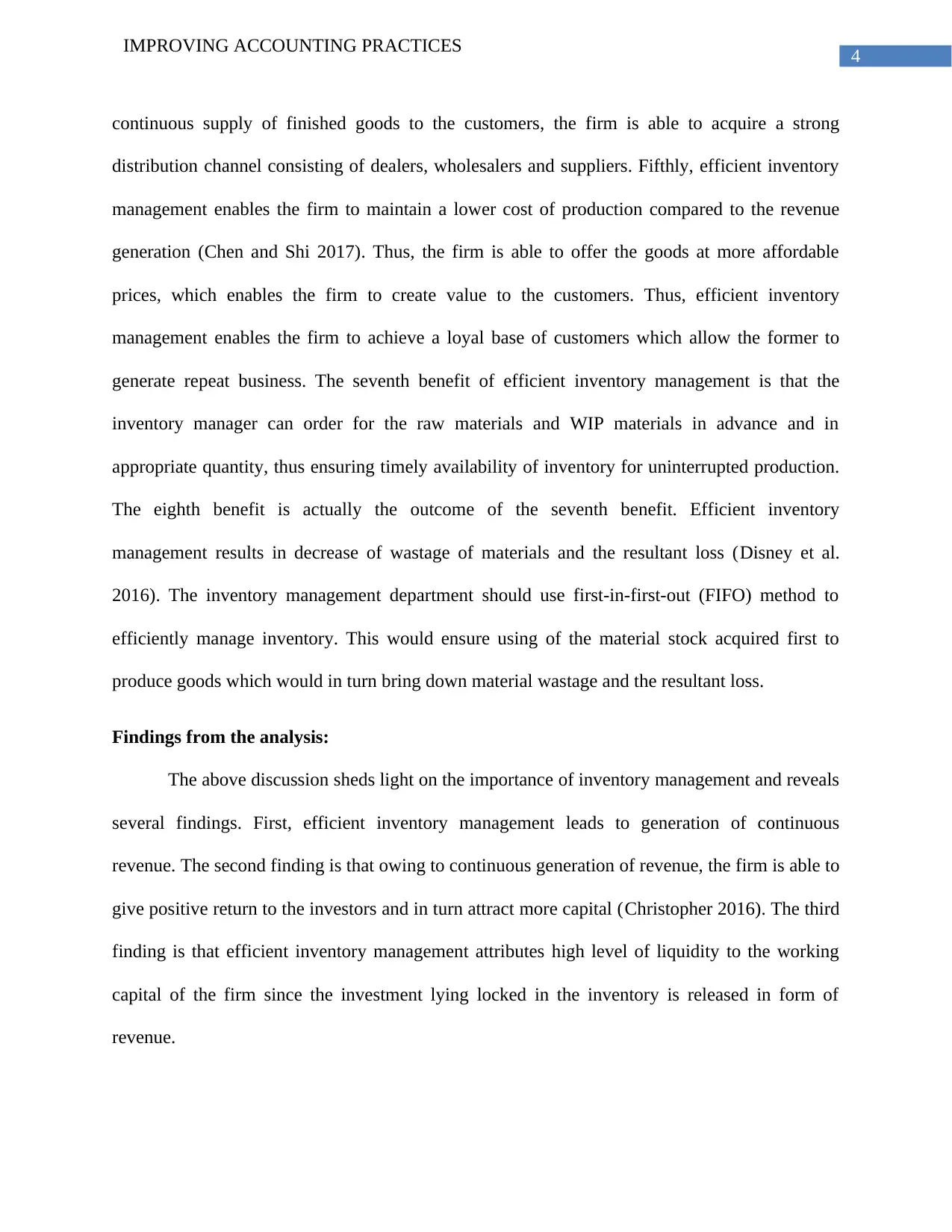
4
IMPROVING ACCOUNTING PRACTICES
continuous supply of finished goods to the customers, the firm is able to acquire a strong
distribution channel consisting of dealers, wholesalers and suppliers. Fifthly, efficient inventory
management enables the firm to maintain a lower cost of production compared to the revenue
generation (Chen and Shi 2017). Thus, the firm is able to offer the goods at more affordable
prices, which enables the firm to create value to the customers. Thus, efficient inventory
management enables the firm to achieve a loyal base of customers which allow the former to
generate repeat business. The seventh benefit of efficient inventory management is that the
inventory manager can order for the raw materials and WIP materials in advance and in
appropriate quantity, thus ensuring timely availability of inventory for uninterrupted production.
The eighth benefit is actually the outcome of the seventh benefit. Efficient inventory
management results in decrease of wastage of materials and the resultant loss (Disney et al.
2016). The inventory management department should use first-in-first-out (FIFO) method to
efficiently manage inventory. This would ensure using of the material stock acquired first to
produce goods which would in turn bring down material wastage and the resultant loss.
Findings from the analysis:
The above discussion sheds light on the importance of inventory management and reveals
several findings. First, efficient inventory management leads to generation of continuous
revenue. The second finding is that owing to continuous generation of revenue, the firm is able to
give positive return to the investors and in turn attract more capital (Christopher 2016). The third
finding is that efficient inventory management attributes high level of liquidity to the working
capital of the firm since the investment lying locked in the inventory is released in form of
revenue.
IMPROVING ACCOUNTING PRACTICES
continuous supply of finished goods to the customers, the firm is able to acquire a strong
distribution channel consisting of dealers, wholesalers and suppliers. Fifthly, efficient inventory
management enables the firm to maintain a lower cost of production compared to the revenue
generation (Chen and Shi 2017). Thus, the firm is able to offer the goods at more affordable
prices, which enables the firm to create value to the customers. Thus, efficient inventory
management enables the firm to achieve a loyal base of customers which allow the former to
generate repeat business. The seventh benefit of efficient inventory management is that the
inventory manager can order for the raw materials and WIP materials in advance and in
appropriate quantity, thus ensuring timely availability of inventory for uninterrupted production.
The eighth benefit is actually the outcome of the seventh benefit. Efficient inventory
management results in decrease of wastage of materials and the resultant loss (Disney et al.
2016). The inventory management department should use first-in-first-out (FIFO) method to
efficiently manage inventory. This would ensure using of the material stock acquired first to
produce goods which would in turn bring down material wastage and the resultant loss.
Findings from the analysis:
The above discussion sheds light on the importance of inventory management and reveals
several findings. First, efficient inventory management leads to generation of continuous
revenue. The second finding is that owing to continuous generation of revenue, the firm is able to
give positive return to the investors and in turn attract more capital (Christopher 2016). The third
finding is that efficient inventory management attributes high level of liquidity to the working
capital of the firm since the investment lying locked in the inventory is released in form of
revenue.
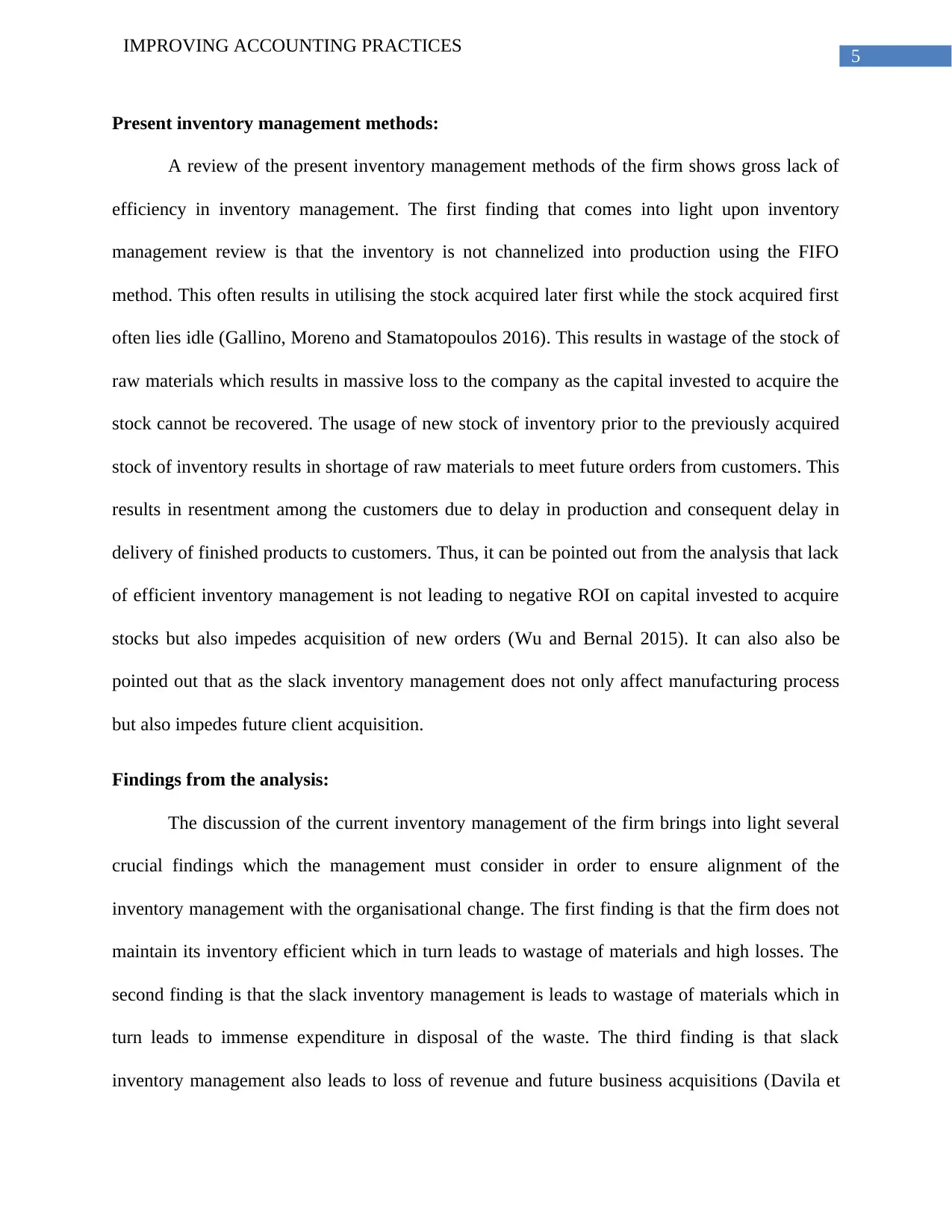
5
IMPROVING ACCOUNTING PRACTICES
Present inventory management methods:
A review of the present inventory management methods of the firm shows gross lack of
efficiency in inventory management. The first finding that comes into light upon inventory
management review is that the inventory is not channelized into production using the FIFO
method. This often results in utilising the stock acquired later first while the stock acquired first
often lies idle (Gallino, Moreno and Stamatopoulos 2016). This results in wastage of the stock of
raw materials which results in massive loss to the company as the capital invested to acquire the
stock cannot be recovered. The usage of new stock of inventory prior to the previously acquired
stock of inventory results in shortage of raw materials to meet future orders from customers. This
results in resentment among the customers due to delay in production and consequent delay in
delivery of finished products to customers. Thus, it can be pointed out from the analysis that lack
of efficient inventory management is not leading to negative ROI on capital invested to acquire
stocks but also impedes acquisition of new orders (Wu and Bernal 2015). It can also also be
pointed out that as the slack inventory management does not only affect manufacturing process
but also impedes future client acquisition.
Findings from the analysis:
The discussion of the current inventory management of the firm brings into light several
crucial findings which the management must consider in order to ensure alignment of the
inventory management with the organisational change. The first finding is that the firm does not
maintain its inventory efficient which in turn leads to wastage of materials and high losses. The
second finding is that the slack inventory management is leads to wastage of materials which in
turn leads to immense expenditure in disposal of the waste. The third finding is that slack
inventory management also leads to loss of revenue and future business acquisitions (Davila et
IMPROVING ACCOUNTING PRACTICES
Present inventory management methods:
A review of the present inventory management methods of the firm shows gross lack of
efficiency in inventory management. The first finding that comes into light upon inventory
management review is that the inventory is not channelized into production using the FIFO
method. This often results in utilising the stock acquired later first while the stock acquired first
often lies idle (Gallino, Moreno and Stamatopoulos 2016). This results in wastage of the stock of
raw materials which results in massive loss to the company as the capital invested to acquire the
stock cannot be recovered. The usage of new stock of inventory prior to the previously acquired
stock of inventory results in shortage of raw materials to meet future orders from customers. This
results in resentment among the customers due to delay in production and consequent delay in
delivery of finished products to customers. Thus, it can be pointed out from the analysis that lack
of efficient inventory management is not leading to negative ROI on capital invested to acquire
stocks but also impedes acquisition of new orders (Wu and Bernal 2015). It can also also be
pointed out that as the slack inventory management does not only affect manufacturing process
but also impedes future client acquisition.
Findings from the analysis:
The discussion of the current inventory management of the firm brings into light several
crucial findings which the management must consider in order to ensure alignment of the
inventory management with the organisational change. The first finding is that the firm does not
maintain its inventory efficient which in turn leads to wastage of materials and high losses. The
second finding is that the slack inventory management is leads to wastage of materials which in
turn leads to immense expenditure in disposal of the waste. The third finding is that slack
inventory management also leads to loss of revenue and future business acquisitions (Davila et
⊘ This is a preview!⊘
Do you want full access?
Subscribe today to unlock all pages.

Trusted by 1+ million students worldwide
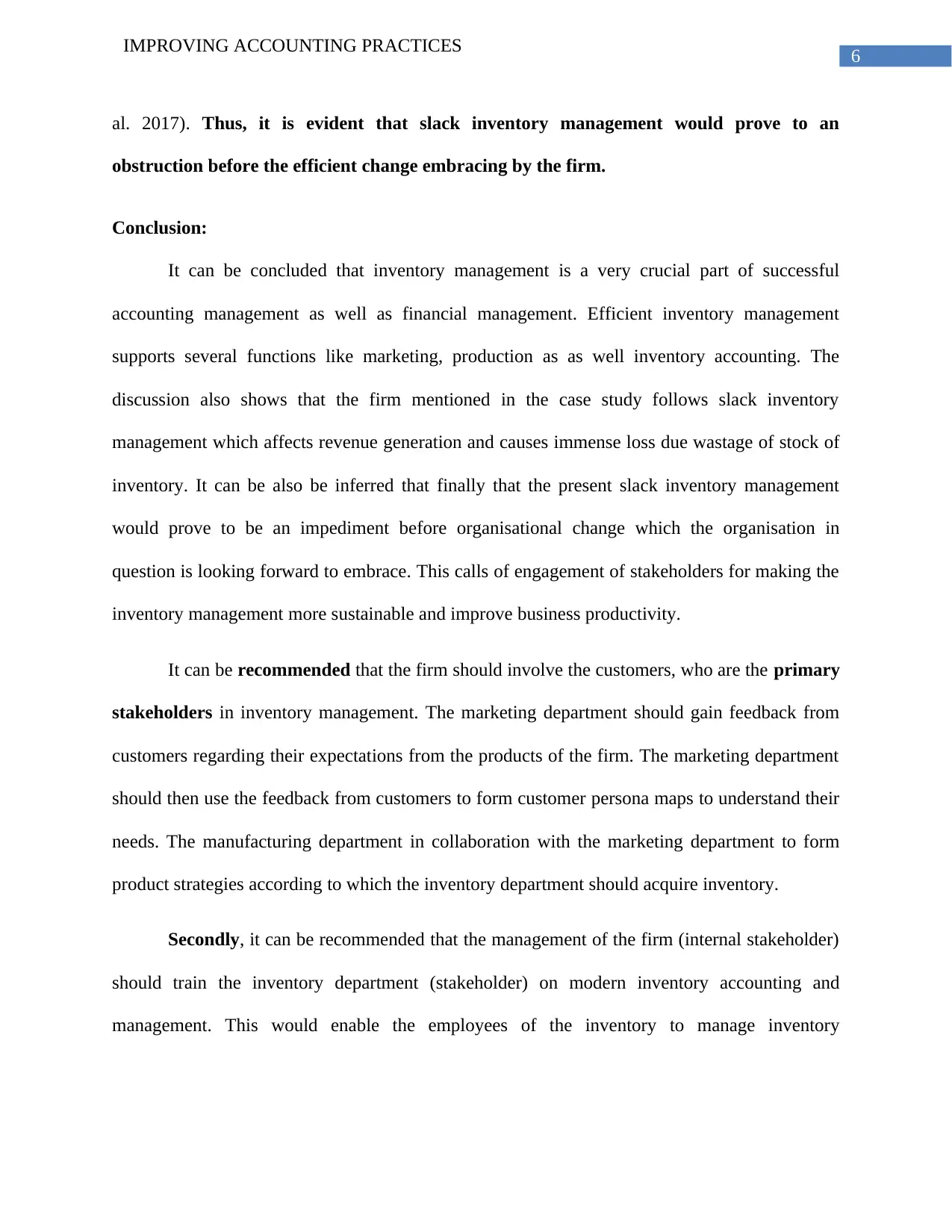
6
IMPROVING ACCOUNTING PRACTICES
al. 2017). Thus, it is evident that slack inventory management would prove to an
obstruction before the efficient change embracing by the firm.
Conclusion:
It can be concluded that inventory management is a very crucial part of successful
accounting management as well as financial management. Efficient inventory management
supports several functions like marketing, production as as well inventory accounting. The
discussion also shows that the firm mentioned in the case study follows slack inventory
management which affects revenue generation and causes immense loss due wastage of stock of
inventory. It can be also be inferred that finally that the present slack inventory management
would prove to be an impediment before organisational change which the organisation in
question is looking forward to embrace. This calls of engagement of stakeholders for making the
inventory management more sustainable and improve business productivity.
It can be recommended that the firm should involve the customers, who are the primary
stakeholders in inventory management. The marketing department should gain feedback from
customers regarding their expectations from the products of the firm. The marketing department
should then use the feedback from customers to form customer persona maps to understand their
needs. The manufacturing department in collaboration with the marketing department to form
product strategies according to which the inventory department should acquire inventory.
Secondly, it can be recommended that the management of the firm (internal stakeholder)
should train the inventory department (stakeholder) on modern inventory accounting and
management. This would enable the employees of the inventory to manage inventory
IMPROVING ACCOUNTING PRACTICES
al. 2017). Thus, it is evident that slack inventory management would prove to an
obstruction before the efficient change embracing by the firm.
Conclusion:
It can be concluded that inventory management is a very crucial part of successful
accounting management as well as financial management. Efficient inventory management
supports several functions like marketing, production as as well inventory accounting. The
discussion also shows that the firm mentioned in the case study follows slack inventory
management which affects revenue generation and causes immense loss due wastage of stock of
inventory. It can be also be inferred that finally that the present slack inventory management
would prove to be an impediment before organisational change which the organisation in
question is looking forward to embrace. This calls of engagement of stakeholders for making the
inventory management more sustainable and improve business productivity.
It can be recommended that the firm should involve the customers, who are the primary
stakeholders in inventory management. The marketing department should gain feedback from
customers regarding their expectations from the products of the firm. The marketing department
should then use the feedback from customers to form customer persona maps to understand their
needs. The manufacturing department in collaboration with the marketing department to form
product strategies according to which the inventory department should acquire inventory.
Secondly, it can be recommended that the management of the firm (internal stakeholder)
should train the inventory department (stakeholder) on modern inventory accounting and
management. This would enable the employees of the inventory to manage inventory
Paraphrase This Document
Need a fresh take? Get an instant paraphrase of this document with our AI Paraphraser
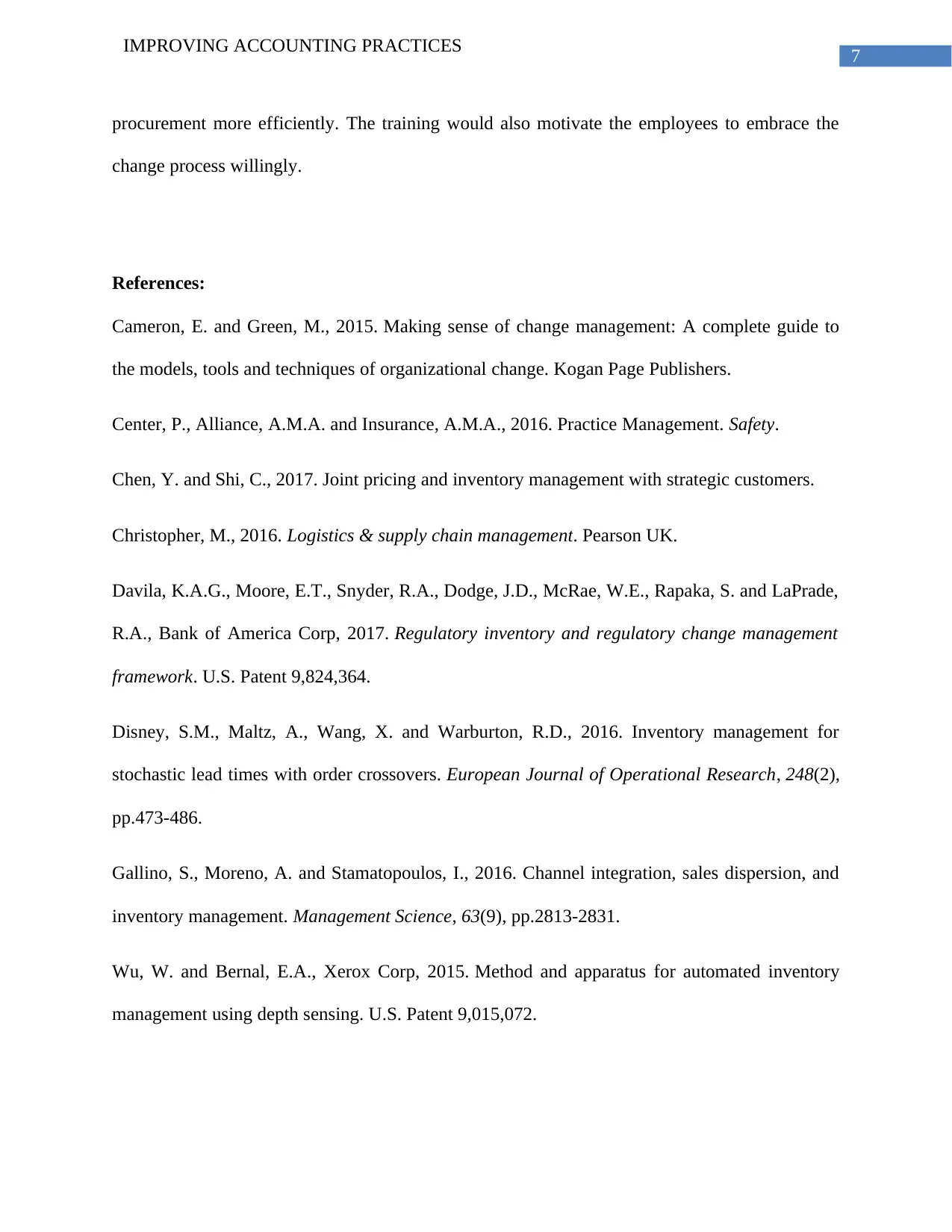
7
IMPROVING ACCOUNTING PRACTICES
procurement more efficiently. The training would also motivate the employees to embrace the
change process willingly.
References:
Cameron, E. and Green, M., 2015. Making sense of change management: A complete guide to
the models, tools and techniques of organizational change. Kogan Page Publishers.
Center, P., Alliance, A.M.A. and Insurance, A.M.A., 2016. Practice Management. Safety.
Chen, Y. and Shi, C., 2017. Joint pricing and inventory management with strategic customers.
Christopher, M., 2016. Logistics & supply chain management. Pearson UK.
Davila, K.A.G., Moore, E.T., Snyder, R.A., Dodge, J.D., McRae, W.E., Rapaka, S. and LaPrade,
R.A., Bank of America Corp, 2017. Regulatory inventory and regulatory change management
framework. U.S. Patent 9,824,364.
Disney, S.M., Maltz, A., Wang, X. and Warburton, R.D., 2016. Inventory management for
stochastic lead times with order crossovers. European Journal of Operational Research, 248(2),
pp.473-486.
Gallino, S., Moreno, A. and Stamatopoulos, I., 2016. Channel integration, sales dispersion, and
inventory management. Management Science, 63(9), pp.2813-2831.
Wu, W. and Bernal, E.A., Xerox Corp, 2015. Method and apparatus for automated inventory
management using depth sensing. U.S. Patent 9,015,072.
IMPROVING ACCOUNTING PRACTICES
procurement more efficiently. The training would also motivate the employees to embrace the
change process willingly.
References:
Cameron, E. and Green, M., 2015. Making sense of change management: A complete guide to
the models, tools and techniques of organizational change. Kogan Page Publishers.
Center, P., Alliance, A.M.A. and Insurance, A.M.A., 2016. Practice Management. Safety.
Chen, Y. and Shi, C., 2017. Joint pricing and inventory management with strategic customers.
Christopher, M., 2016. Logistics & supply chain management. Pearson UK.
Davila, K.A.G., Moore, E.T., Snyder, R.A., Dodge, J.D., McRae, W.E., Rapaka, S. and LaPrade,
R.A., Bank of America Corp, 2017. Regulatory inventory and regulatory change management
framework. U.S. Patent 9,824,364.
Disney, S.M., Maltz, A., Wang, X. and Warburton, R.D., 2016. Inventory management for
stochastic lead times with order crossovers. European Journal of Operational Research, 248(2),
pp.473-486.
Gallino, S., Moreno, A. and Stamatopoulos, I., 2016. Channel integration, sales dispersion, and
inventory management. Management Science, 63(9), pp.2813-2831.
Wu, W. and Bernal, E.A., Xerox Corp, 2015. Method and apparatus for automated inventory
management using depth sensing. U.S. Patent 9,015,072.

8
IMPROVING ACCOUNTING PRACTICES
IMPROVING ACCOUNTING PRACTICES
⊘ This is a preview!⊘
Do you want full access?
Subscribe today to unlock all pages.

Trusted by 1+ million students worldwide
1 out of 9
Related Documents
Your All-in-One AI-Powered Toolkit for Academic Success.
+13062052269
info@desklib.com
Available 24*7 on WhatsApp / Email
![[object Object]](/_next/static/media/star-bottom.7253800d.svg)
Unlock your academic potential
Copyright © 2020–2025 A2Z Services. All Rights Reserved. Developed and managed by ZUCOL.





